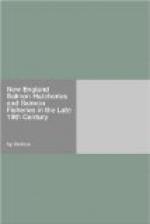“There is a certain mystery about the habits and movements of the sea salmon, after it has left the fresh-water rivers in which it spawns and gone down to the sea, that never has been satisfactorily explained. One theory is that all the salmon of the rivers along a coast may journey down to the sea, and then move ultimately in one great body southward along the coast until they find water of suitable temperature, with an abundance of food, in which to spend their time in growing fat until the spawning instinct warns them to return, when they proceed northward, each river school entering its own particular river as the main school arrives opposite the river month.
“Another theory is that the salmon of each river, as they arrive at its mouth after descending from its headwaters, go out to sea sufficiently far to find the conditions of temperature and food which suit them, and there they remain, separate from the salmon of other rivers, until it is time for them to return to fresh water. Considering the certainty with which the salmon of any particular river return again to the stream of their birth, the latter theory seems the more tenable of the two.”
Another object of this paper is to solicit correspondence from fishermen, especially those engaged in the coast and offshore fisheries, concerning the circumstances of the capture of salmon in their nets, and to bring to their attention the opportunity they will thus have of increasing the knowledge of the movements of the salmon, of aiding in the determination of the results of fishcultural operations, and of ultimately if not immediately benefiting themselves by supplying information that will conduce to the most effective application of artificial methods.
To this end it is the intention to send the paper to fishermen engaged in the mackerel, menhaden, and other sea fisheries, and to operators of pound nets, traps, and other shore appliances, with the hope that instances of the capture of salmon may be communicated to this Commission and notes on the size, condition, movements, etc., of the fish be furnished.
To aid in the identification of the salmon when caught by fishermen who have not previously met with the fish, a figure is presented.
In this connection mention may be made of the chinook or quinnat salmon of the Pacific coast (Oncorhynchus chouicha), fry of which have been extensively planted in eastern waters by the U. S. Commission of Fish and Fisheries. Up to and including the year 1880, about 12,000,000 fry were deposited in rivers and other waters tributary to the Atlantic. While a few relatively large examples have been taken, this office has no information to show that the attempts to acclimate this species on the Atlantic coast have as yet been successful. In 1891 a few thousand yearling salmon were placed in New York waters tributary to the sea. The possibility of the survival and growth of some of these and of the large early colonies prompts this reference to the matter and suggests the publication of the accompanying figure of the species, to afford a basis for distinguishing the two kinds of salmon, which closely resemble each other. To further aid in the identification of the two species the following key has been prepared:




